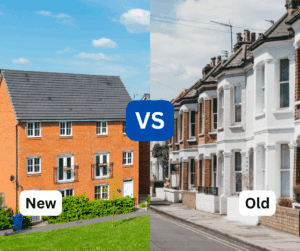Why Is Supply Rising So Quickly? (Affordability Is the Main Factor)
- The sharp rise in mortgage rates has significantly increased monthly repayments. In 2020, the average rate was around 2.4%; now, common fixed rates are 4.5–5%. For a £200,000 loan, that means a jump from roughly £850 to £1,150 per month — about £300 more in interest alone. For many households, this is a decisive difference.
- Around 1.8 million fixed-rate mortgage deals will expire over the next 12–18 months. Many owners who bought at low rates and stretched their finances to the limit could be forced to sell when faced with much higher refinancing costs, further boosting supply.
- Age and debt distribution magnify the effect: older homeowners are more likely to have no mortgage debt, while younger cohorts — particularly those under 45 — carry the bulk of mortgage obligations. Affordability pressures therefore hit younger owners disproportionately, increasing the risk of forced sales among this group.
Landlords Selling Up — Another Supply Driver
- Q1 data shows that a significant share of listings are former rental properties — roughly one in six. This suggests that many landlords are exiting the market.
- Reasons include higher mortgage costs, reduced profitability due to tax changes (such as Section 24), and policy uncertainty from regulation (e.g., the anticipated Renters Reform Bill). Many small landlords are cashing out, while larger institutional players (operating via limited companies or SPVs) are becoming more active, reshaping the rental market’s supply-demand dynamics.
Changing Buyer Behaviour: Less Urgency, More Negotiating Power
- Rightmove notes that buyer demand remains present, but with more choice, buyers are more willing to negotiate — a key reason why high-value areas are seeing sharper price falls.
Refinancing Risks Ahead
- While there is evidence that mortgage rates have been easing in recent months, the large wave of deal expirations means many owners will soon face higher rates than during the low-interest era. This is likely to release further supply onto the market over the next 12–18 months. Some will successfully refinance or restructure, but those whose incomes have not kept pace with rate rises may be forced to sell.
Implications for Different Groups
- First-time buyers: More choice and greater negotiating room, but ensure mortgage eligibility and prepare for rate volatility. Take advantage of falling rates without overleveraging.
- Homeowners looking to sell: In high-value areas such as Southern England and London, price competitively and maximise property appeal, or risk being squeezed in an oversupplied market.
- Refinancers / those with expiring deals: Review contracts early and act quickly to secure favourable rates. Even with declining rates, good deals can be short-lived; stress-test cash flow by modelling rates 1–2% higher.
- Investor landlords: Monitor policy and tax risks closely, and reassess holding structures (personal vs company) and cash flow. Smaller landlords under margin pressure may continue adding to market supply.
Conclusion
Higher interest rates, the expiry of fixed-rate deals, and regulatory changes are collectively driving up housing supply and putting downward pressure on prices. For astute buyers and investors, this environment presents both challenges and opportunities — but success will depend on disciplined cash flow management and rigorous risk assessment.







